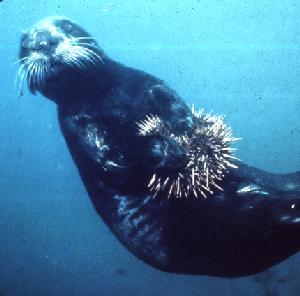- Home
- About S&T
- Taxa/Organisms
- Ecosystems
- Issues
- Methods & Tools
- Reports & Publications
- Location
- Search
Publisher: USGS | Science Center: Patuxent Wildlife Research Center (PWRC, Laurel) | Format: URL
www.pwrc.usgs.gov — Information about ecotoxicological exposure and its effects on terrestrial vertebrates residing in estuarine and coastal habitats like the Atlantic, Gulf and Pacific Coasts, Alaska and Hawaii, as well as the Great Lakes. These vertebrates include birds, mammals, amphibians and reptiles. The data is a compilation of results from computerized More...

September 2005 | Publisher: USGS (Soundwaves) | Science Center: USGS Other | Format: URL
soundwaves.usgs.gov — Biologists in the Sirenia Project at the U.S. Geological Survey (USGS) Florida Integrated Science Center (FISC) in Gainesville, FL, are currently identifying and mapping the genetic material of manatees. Their goal is to better understand and predict the manatee's ability to react to environmental stimuli, such as prolonged periods of cold More...

May 2005 | Publisher: USGS | Science Center: National Wildlife Health Center (NWHC, Madison) | Format: .PDF
www.nwhc.usgs.gov — Recent increases in the frequency and variety of infectious diseases in the southern sea otter may jeopardize the population recovery of this threatened species. This information sheet includes a list of selected publications.

Publisher: USGS | Science Center: Western Ecological Research Center (WERC, Sacramento) | Format: URL
www.werc.usgs.gov — Sea otters (Enhydra lutris) are keystone predators in the nearshore environment of the eastern Pacific Ocean, in a food web composed of sea otter, sea urchin, and kelp forest. Without sea otters, the kelp forest can be overgrazed by sea urchins, which in turn can affect other species that depend on this ecosystem. This resource provides links to More...

Publisher: USGS | Science Center: Alaska Science Center (ASC, Anchorage) | Format: URL
alaska.usgs.gov — This study is a new analytical procedure that quantifies the degree of overlap between adjacent populations of polar bears, and provides science for better management of the harvest of polar bears in the Beaufort and Chukchi Seas. This new analytical approach allows previously accepted population management units to be subdivided in ways that will More...

Publisher: USGS | Science Center: Patuxent Wildlife Research Center (PWRC, Laurel) | Format: URL
www.pwrc.usgs.gov — This report assesses and forecasts the status of the Florida manatee population over 50 to 150 years, and examines the relative roles that different threats play in determining the status of these marine mammals, in cooperation with scientists at the Florida Fish and Wildlife Conservation Commission's Fish and Wildlife Research Institute (FWC). More...

Publisher: NBII | Format: URL
www.nbii.gov — Natural resource managers face complex decisions that require a clear understanding of the status of wildlife populations and their habitats. Monitoring is key to making effective management decisions and evaluating the outcomes of those decisions. The goal of NRMP is to improve the accessibility of monitoring efforts to resource managers to aid More...

Publisher: USGS | Science Center: Fort Collins Science Center (FORT, Ft. Collins) | Format: URL
www.fort.usgs.gov — Natural Resource Monitoring Partnership (NRMP) is a collaborative effort by the natural resource management community to improve monitoring efforts in order to support effective evaluation and decision-making by sharing information on monitoring projects and protocols. The Natural Resource Monitoring Partnership was built for easy access to More...

Publisher: USGS | Science Center: Alaska Science Center (ASC, Anchorage) | Format: URL
www.absc.usgs.gov — A web page to introduce research by the USGS Alaska Science Center on sea otter population status and changes in Alaska. Provides some background on why the research is needed, research objectives, and a listing of publications by project staff.

Publisher: USGS | Science Center: Alaska Science Center (ASC, Anchorage) | Format: URL
alaska.usgs.gov — This web page links to resources related to the abundance and vital rates of polar bears. It includes Polar bear population status in the southern Beaufort Sea, and Survival and population size of polar bears in relation to earlier sea ice breakup. The site also links to resources that deal with tracking polar bears via satellite, polar bear-sea More...

Publisher: USGS | Science Center: Alaska Science Center (ASC, Anchorage) | Format: .PDF
www.absc.usgs.gov — An extensive and diverse array of studies were implemented concurrent with and for several years following the Exxon Valdez oil spill to determine the acute and chronic effects to sea otters. In part, this paper describes what activities relative to sea otters should take place prior to, during, and following another spill similar to the Exxon More...

Publisher: USGS | Science Center: Western Ecological Research Center (WERC, Sacramento) | Format: URL
www.werc.usgs.gov — Management agencies are interested in the development of a realistic predictive model of the southern sea otter population recovery and range expansion into southern California, as this would facilitate the informed assessment of potential impacts of sea otters on important industries (e.g., fisheries, eco-tourism), potential negative effects of More...
